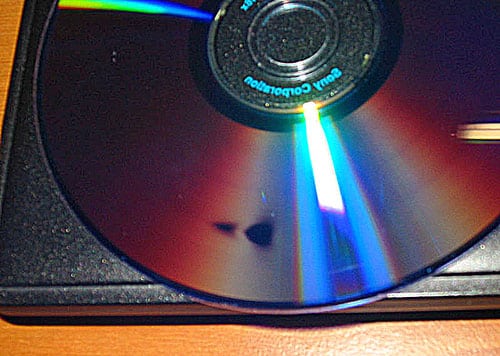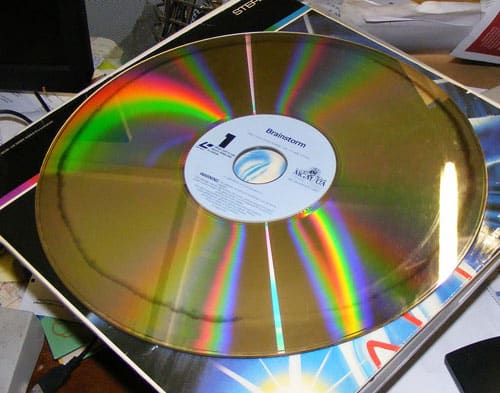Today in Tedium: Often, it looks like a coffee stain—a noticeable discoloration that for whatever reason you can’t get rid of. Sometimes, it looks like tiny pin pricks on the surface. And there are other times when the whole thing changes color. In any case, when you run into what’s known as “disc rot,” you’re out a great album or an interesting movie. It’s a serious situation, whether you’re a digital archivist or simply someone who wants to watch a movie on a weird format like a Laserdisc. Today’s Tedium dives head first into the decay. — Ernie @ Tedium
“I suppose that if you ran a knife over a disc it would not do it any good, and you might destroy it if you stubbed out of cigar on it. But you could pour jam on it without causing any damage.”
— A spokesperson for EMI, commenting on research done on the permanence of compact discs by the record label Nimbus in 1988. Nimbus, the first CD manufacturer in the U.K., said that it had done some research into the disc rot issue and found that most discs will self-destruct after between eight and 10 years. The company’s findings, which went against prevailing theories of the time that CDs were indestructible, blamed the problems on improper dyes that reduced the quality of the discs. As highlighted by the quote, record companies were at first skeptical, but Nimbus’ concerns about disc integrity turned out to be important and true.

Why “disc rot” is a massive challenge for both archivists and collectors
Back in 2010, a blogger on the video game website RF Generation, frustrated with a series of purchases in which the games had suffered a degree of “disc rot” before reaching him, wrote a PSA to the game-collector community, calling on them to keep an eye out regarding the problem.
The blogger, who goes under the pseudonym “slackur” or “Jesse Mysterious,” then described a harrowing tale for a serious collector: After reading up on the disc rot problem, he went through his game collection, much of it in mint condition, and found white specs on many of the discs—a major tell sign of “disc rot,” or the eventual decay of optical media.
I’ll let him take it from here:
Even though it is only one little dot, it represents damage that cannot be repaired. No scratch removal process can restore the data that is now lost. The game is forever damaged, and likely to get worse over the years.
Now, many sources online will claim that disc rot is a limited-scope problem, concerning only a few years worth of discs from certain manufacturers, (and CD-Rs) and that it is not wide-spread.
But when I learned about this problem, I checked my several hundred discs between Sega CD, Turbo CD, Saturn, and even Dreamcast games and found DOZENS had this problem. Several expensive games I owned were mint—except when held to the light I could see one or more little white dots that proved my game had damage. Some of these I went back to play after not touching for years and found they now would occasionally lock up or not play at all. I had a few FACTORY SEALED games that I opened and found the same thing.
It has been a nerve-shattering nightmare for a collector like me.
Michele Youket, a preservation specialist at the Library of Congress, often deals with similar situations in her role. She says that this kind of silent destruction, which shows up in three different forms—the “bronzing” of discs, small pin-hole specs located on the discs, or “edge-rot”—became an important one for the national library when the organization started archiving music on CD formats, with the format’s weaknesses soon becoming apparent.
The thing to keep in mind about optical discs is that, although they generally look the same, there are often notable, but minor, differences in how the discs are produced can have significant effects on the end results. An older disc might not use the same chemicals as a newer one, and over time, techniques tend to become more sophisticated.
“Many of the causes of early failures of these discs would disappear as the technology matured. However, as new and more complex formats of these discs were introduced other mechanisms of failure would appear,” Youket explained.
(By the way, she calls the “disc rot” terminology inexact, because when it comes down to it, the discs failed because the protective covering didn’t do its job.)
Whether you’re trying to protect your country’s cultural heritage or your own collection, it’s safe to say that disc rot is a huge, lingering problem.
15
The number of years that a major British CD manufacturer, Philips and Dupont Optical (PDO) operated a customer support line specifically so it could replace consumers’ “bronzed” discs. Here’s what happened: Between 1988 and 1993, PDO pressed a number of CDs that used an inferior lacquer that wasn’t resistant to sulphur, which was a problem because there were trace amounts of sulphur in the attached books and CD inlays—meaning the stuff meant to protect the disc would damage it. This led the aluminum layer to eventually corrode, making the discs look bronze in color—and damaging the quality on the audio of the discs. PDO ran a hotline, allowing music-buyers to exchange these damaged discs, between 1991 and 2006.

Library of Congress preservation specialist Michele Youket, shown assessing a CD for damage. (Amanda Reynolds/Library of Congress)
Five notable facts about “disc rot,” according to the Library of Congress
- Discs with significant errors are often still at least partially readable, according to Youket. “In the case that a disc has an uncorrectable error, depending on where this error occurs much of the data is still recoverable,” she explained in an interview. “Many discs with high errors are still playable, and depending on the content—audio, video, or data—even an uncorrectable error may not be serious.”
- A scratch at the top of a CD is more problematic than one on the bottom. Why’s that? Youket says that the standards for these optical formats include built-in error-correction schemes that can work around scratches in at the bottom of the discs. “However,” she says, “because the reflective layer is only covered by a thin coating of acrylic with an ink-printed label, scratches to the top surface can penetrate through and damage the reflective layer.”
- DVDs generally have better integrity than do CDs because the disc’s reflective layer is pressed inside the polycarbonate discs. But the discs are often more susceptible to breaking apart due to chemical reactions between the layers and the polycarbonate discs—and as a result, layers can delaminate over time. Dual-layer discs, however, tend not to hold up so well.
- Recordable discs don’t last as long, in part because of the organic dye used to record the bytes onto discs, which Youket says is vulnerable to degradation—particularly in the case of recordable DVDs, which have higher levels of light sensitivity, making them more susceptible to failure. Additionally, she says the way a recordable disc is burned is a major factor in defining its lifespan—a poorly recorded disc tends to wear out more quickly.
- Proper storage and handling helps. Ultimately, Youket notes that, according to LoC’s own aging tests (which determined the life expectancy of discs based on changes in their bit-level error rate), discs are much more likely to survive over long periods if they’re handled correctly and stored in good conditions. “These studies have shown that a well-made pressed compact disc can last many decades if stored and handled properly,” she noted, adding that “discs that are stored in harsh environmental conditions with elevated temperature and/or humidity will have shorter expected lifetimes than discs stored in more controlled conditions.”

(via Wikimedia Commons)
Laserdisc owners can tell you all about the horrors of “laser rot”
If CD or DVD owners wanted to know what they were in for, all they had to do was ask Laserdisc owners, who were all too familiar with the early demise of their paid-for media all the way back in the ’80s.
In fact, the term used by Laserdisc owners is “laser rot,” highlighting its first-mover importance in optical media.
In the case of Laserdiscs, the glitches show themselves largely when playing the discs, which initially highlight small flecks of snow when playing the films, then devolve from there. The discs themselves often take on a cloudy appearance (as shown in this YouTube clip highlighting the rot on a copy of Saturday Night Fever) and the result is often quite disappointing considering the platform’s reputation for high picture and sound quality.
The problem is so widespread in the Laserdisc community that the Laserdisc Database (LDDB), a hub for collectors, has an entire page dedicated to listing the most prevalent films featuring such issues with decay—essentially as a way to warn its members not to buy specific discs.
See, much like the PDO factory giving British CD owners discs that eventually turned bronze, a U.S factory is often the target of blame for Laserdisc’s many woes—specifically Sony’s DADC factory, based in Indiana.
If you dig far enough, you’ll find all sorts of conspiracy theories about why this Sony factory, far more than any other manufacturer, was building discs that weren’t made to last.
“Over the years, most pressing plants had problems with rot at one time or another, but most of them managed to clean themselves up,” Josh “Laserdisc Guru” Zyber wrote on his website in 2005. “DADC never did.”
The trouble that Laserdiscs face means the people are always looking for ways to preserve what they had. Last year, Engadget writer Sean Cooper discussed how he was nearly stuck throwing out a copy of the original Dragon’s Lair arcade cabinet, because he couldn’t find a working copy of the original disc—makes sense, considering it was in production more than 30 years ago.
Ultimately, Cooper was forced to replace the original disc with a Raspberry Pi. Maybe not as authentic, but at least it works.
There’s obviously something to be said about enjoying a piece of entertainment in its original format, but when it’s out of the view of the mainstream, both companies and the bulk of consumers are often ready to move on to the next thing.
But where does that leave the stuff in the older format? Often, businesses tend not to be the greatest shepherds of the formats they sell once they fall out of mainstream interest.
While the Library of Congress’ Youket cites the existence of “archival-grade” recordable discs as a way to better keep things safe in the long-term, her LoC colleague Peter Alyea, a digital conversion specialist, says that the shift to cloud computing has likely pushed companies away from supporting their data formats in the long run.
“With the move away from physical media at the consumer level, I think this isn’t the question most companies are wrestling with these days,” he explained to me in an interview. “Consumers are more interested in long term accessibility to personal data archived on remote storage and access to entertainment (music, video, games) at the moment they desire it. It would be nice if manufacturers always place high importance on the long-term integrity of this products, but it is probably not realistic to expect that.”
Things age, and stuff inevitably loses its luster with the passage of time. But in the age of the cloud, at least, consumers are pretty close to making it someone else’s problem.
Archivists don’t have that luxury.




